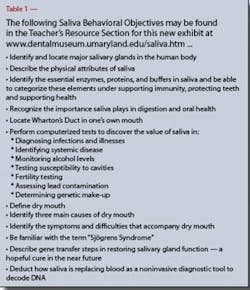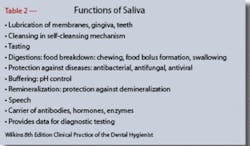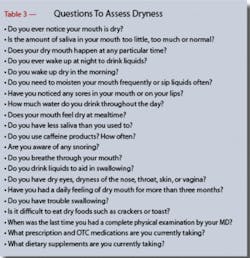Saliva gets NO RESPECT!
We take saliva for granted, but when this natural function is diminished or stops, quality of life can drastically change.
It takes two quick licks to seal an envelope, yet people without saliva to spare must reach for the tape. Have you ever had such a dry mouth that you drank gallons of water a day, and it didn’t help? One client described her dryness as her tongue and palate feeling like “two halves of Velcro.” Saliva, that tasteless liquid mixture produced by the salivary glands and sometimes called spit, is something most clients never think about.
Rodney Dangerfield’s catchphrase, “I don’t get no respect,” is well known. Although saliva is a healing fluid and potential indicator of systemic wellness, it has a Rodney Dangerfield reputation - it gets no respect. Most medical clinicians place dry mouth in a category that does not require a physician’s care. Dry mouth is often regarded as a petty complaint, so there is no compelling health reason to assess it. Many hygiene professionals don’t notice it, don’t ask about it, and even give misinformation about it. Saliva is often neglected during routine hygiene checks because time is so limited. We take saliva for granted, but when this natural function is diminished or stops, quality of life can drastically change.
Nancy’s story
Nancy has a very bad case of dry mouth. She’s had it for many years and drinks a lot of water, but it doesn’t help. She visits her dental hygienist for routine six-month care, which consists of a cleaning, exam, and sometimes X-rays. When Nancy is asked, “Has your health changed since you were here last here?” the hygienist turns her back and washes her hands when Nancy answers. At the end of the appointment Nancy is told whether or not she has cavities and to floss regularly. Nancy thinks this is what routine hygiene appointments encompass; she doesn’t know any differently. She doesn’t think her hygienist or dentist wants to know about anything else because they never ask.
Nancy has a complex health profile that includes multiple allergies, the most severe of which is an anaphylactic reaction to gluten. She carries an EpiPen, and has had reactions so severe she’s been hospitalized for as long as two to three weeks to get her immune system stabilized. She uses a C-PAP each night for sleep apnea. She takes several medications frequently, and uses a nebulizer to deliver some of those medications. Nancy also suffers from gastroesophageal reflux disease (GERD), and has a family history of thyroid dysfunction, colon cancer, osteoporosis, glaucoma, and more.
Nancy was frustrated during her last dental visit because she had had a bridge fall off several times, and was told she had decay by her front bonding. When she asked her hygienist if dry mouth had anything to do with these changes, she got no answer. She then asked if there was something she could do for her dry mouth. She was told to chew gum and rinse with mouthwash. When she asked if there was a particular kind gum or mouthwash to use, the answer was no.
Nancy’s dental practitioners didn’t notice anything relating to her dry mouth, yet neither did Nancy until it became extreme. When she sought advice from professionals, they either didn’t know, had forgotten, or worse, they thought they knew how to treat dry mouth but actually did potential harm with their advice. Luckily for Nancy, she remembered an old RDH friend and asked her. Her friend spent a great deal of time talking with Nancy about her health and medications, and explaining the harmful effects of dry mouth. The RDH was able to correct the misinformation Nancy had been given and tailor a program for her oral dryness using Biotene toothpaste, mouthwash, oral moisturizer, and gum. Nancy has to talk a lot for her job and the new Oral Balance™ Dry Mouth Moisturizing Liquid has helped her immensely (www.laclede.com). Nancy dropped off product samples at her dental practice, but they never followed up with her. She has decided to seek dental care elsewhere.
It is easy for us to recognize Nancy’s problems through her story. Yet how often is oral dryness ignored? It is estimated that40 percent of the population over age 55 suffers from dry mouth. Unfortunately, dry mouth is on the rise and can affect people of all ages and health levels. When dry mouth is not treated, the mouth’s bio-system can deteriorate. Without saliva, there is an increased risk of caries, gingivitis, periodontal disease, oral infections, and slow-to-heal wounds. Other problems involve difficulty chewing, swallowing, and speaking; impaired taste; cracked lips; fissured tongue; and halitosis. Beyond affecting oral health, decreased saliva flow is a chronic discomfort that can take a toll on a person’s emotional well-being. More than a discomfort, dry mouth is a serious condition that affects dental health and quality of life.
Saliva: A Remarkable Fluid, an exhibition developed by The Dr. Samuel D. Harris National Museum of Dentistry, opened March 2, 2005, at the Baltimore-based museum affiliated with the Smithsonian Institute. This interactive, educational experience is the first of its kind dedicated to the study of human DNA and its connection to dentistry. Saliva: A Remarkable Fluid explains the latest discoveries in genetic research and their promise for improving oral health, overall health, and quality of life for generations to come. The exhibition is the first section of Your Spitting Image, a three-part series. Upon completion, Your Spitting Image will help visitors understand the connections between the Human Genome Project and dentistry in three topical areas - saliva, bioengineering, and forensics. See Table 1. What do you, as an oral health professional, know about connections between the Human Genome Project and dentistry and the three topical areas of saliva, bioengineering, and forensics? Will the public begin to know more about saliva than we do?
Saliva and total health
We know the oral cavity is one of the most important portals into the body. Of all the organs in the oral/dental complex, the salivary glands and the remarkable secretory product they produce forge the strongest link between oral and systemic health. Salivary function is extremely sensitive to the changes in a person’s general well-being.
Let’s review the beginning steps we learned in hygiene school about saliva. Remember the Functions of Saliva from Wilkins? (Table 2) Does this knowledge make any difference in your day-to-day practice?
Saliva represents the first line of defense against foreign pathogens. Saliva allows oral tissues to be cleansed and provides the fluid that moves food and microbes out of the oral cavity. The coating property of saliva can lubricate tooth surfaces as well as contribute a protective layer to oral soft tissues. The remineralization capability of saliva depends on the combination of its uncompromised buffer systems and the systems it employs to maintain calcium and phosphate ions. When the pH of saliva drops to 5.5 or below, the equilibrium favors demineralization. The antimicrobial properties of saliva depend upon a variety of enzymes and proteins that individually have demonstrated antibacterial, antifungal, or antiviral activities. Saliva initiates the general digestive process by the secretion of a variety of digestive enzymes whose role is to degrade food and bacterial remains in the oral cavity. Saliva is also a source of hormones and growth factors.
Saliva can be used to detect oral candidiasis. The salivary levels of pathogens such as Porphyromonas gingivalis, Streptococcus mutans, and Lactobacillus acidophilus can be used in risk assessments for periodontal diseases and dental caries. Elevated levels of some salivary proteins have also been associated with oral squamous cell carcinoma. The risk of oral cancer is higher in individuals who have high salivary levels of nitrate and nitrite. The type and quantity of oral microbes harbored in the oral cavity may contribute to high-risk levels for a number of systemic diseases.
When this natural function stops
The absence or loss of function of any of the beneficial actions of saliva can predispose a person to oral disease. The importance of saliva is never more obvious than when there isn’t any. There is a dramatic impact on oral health as well as a level of discomfort that adversely affects a person’s well-being. Dry mouth must be considered an important risk factor.
Dry mouth and oral dryness are general terms that encompass two medical entities: xerostomia and hyposalivation. Xerostomia is the subjective complaint of oral dryness, and is medically classified as a symptom. Hyposalivation is the objective reduction in salivary secretion as the consequence of reduced salivary function. These conditions are closely related and sometimes interrelated. Some clients who complain of dry mouth do not show any objective evidence of reduced salivary flow, and some with proven objective salivary gland hypofunction do not report symptoms of xerostomia.
Studies have shown that approximately 10 percent of the population has daily xerostomia. In elderly populations (> 65 years old), the prevalence approaches 25 percent, and in institutionalized elders, rates may be as high as 45 to 50 percent. However, xerostomia does not appear to be related to age as much as to the potential for the elderly to take medications that cause xerostomia. Further, the side effects of radiation for head and neck cancers include xerostomia. These side effects may be complicated by damage to the salivary glands, resulting in a lack of saliva.
Are you evaluating saliva during every exam? The importance of including an oral soft-tissue evaluation and cancer screening during a dental examination has long been established. Our profession must recognize the need and value of including an evaluation of salivary function with every dental examination as well as ongoing observations during treatment.
One article can’t cover all there is to know about this important subject. There are many online resources including www.drymouth.info, www.oralcancerfoundation.org, and www.sjogrens.org, information from CE courses, organizations, books, and the dental industry.
How can you do a better job with oral dryness? Take baby steps. Add a few simple questions to your routine health profile update such as: Do you ever notice your mouth is dry? Is the amount of saliva in your mouth too little, too much, or normal? Do you ever wake up at night to drink liquids? Do you wake up with a dry mouth in the morning? Do you need to moisten your mouth frequently or sip liquids often? Have you noticed any sores in your mouth or on your lips? A definitive list of questions is shown in Table 3. By asking questions and documenting the answers, you will probably find many of your clients are suffering more than you realized, and this can help you help them.
Today, the possibility of placing just a few drops of saliva on a microchip to determine the state of a person’s health is well within possibility, according to the American Association of Dental Research. Saliva can become the mirror and monitor of the body’s health, and its analysis will become a routine part of the dental and medical office visit. Saliva has been elevated to a new level of respect in the science and biotechnology world.
It is time to transform our practice from dental hygiene to oral medicine, the 21st century version of dentistry. Oral medicine is much more powerful, effective, and appropriate. It gives clients the benefits of all our knowledge, not just as a technician trained to clean teeth. We can transform our profession and use the knowledge we gained in hygiene school, continuing education, and articles, not just place it on a shelf when we begin practice. With science demonstrating that saliva can be used to assess and monitor systemic health and disease, it might be one of the places we can begin to make this transformation.
Rodney Dangerfield is finally getting respect with his famous red tie in the Smithsonian and a movie about his life being filmed. Saliva should gain respect too, as hygiene professionals start respecting it as the healing fluid and potential indicator of systemic wellness it is. We need to support the development and promotion of saliva as a window into wellness and a means for early disease detection that leads to more effective treatments, risk assessment for oral and systemic diseases, and a noninvasive alternative to blood and urine tests.
Patti DiGangi, RDH, BS, is a speaker, author, and practicing dental hygiene clinician offering CE courses to national audiences through her company, Professional Direction Conferences. She can be reached to schedule courses at [email protected] or (630) 292-1473.




